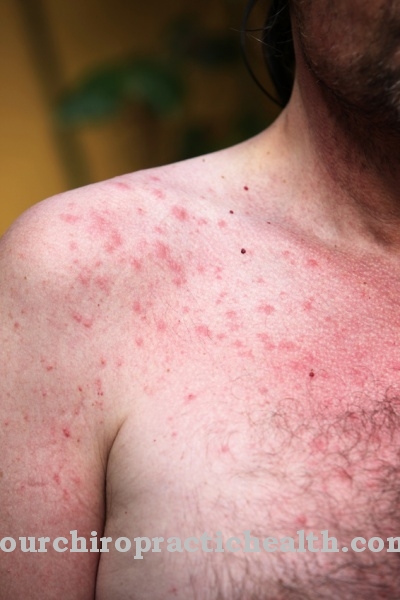The Brucellosis is an infectious disease that is transmitted by certain bacteria, mainly through animals and animal products. If the therapy is started in time, the disease is mostly harmless.
What is brucellosis?

© juefraphoto - stock.adobe.com
Brucellosis is an infectious disease that is caused by bacteria of the Brucella genus. Both humans and animals can be affected. Depending on the pathogen, different brucellosis are distinguished:
The so-called Malta or Mediterranean fever is the type of brucellosis that is most commonly found in humans. It is caused by the species Brucella melitensis, which is native to the Mediterranean region, Africa and Central and South America. Bang's disease, swine and canine brucellosis are rare in humans. In Germany, brucellosis diseases are notifiable.
causes
Brucellosis is usually transmitted to humans through animals. Through direct contact, for example after petting cows or sheep, pathogens can enter the human organism through tiny skin injuries or through the mucous membranes.
Infected raw milk, raw milk products and infected raw meat are also sources of infection. The bacteria can survive in the mentioned foods for several weeks. Animal feces and urine can also contain pathogens. In individual cases, brucellosis can be transmitted directly from person to person while breastfeeding.
Transmission via blood transfusions, bone marrow transplants, and sexual intercourse are extremely rare. If the brucellosis is not recognized correctly or not at all, the disease can become chronic.
You can find your medication here
➔ Medicines for fever and chillsSymptoms, ailments & signs
The symptoms of brucellosis are usually very similar to the usual complaints and symptoms of an infectious disease. In the worst case, the disease can also lead to the death of the person concerned if it is not treated properly or treated late. Those affected suffer primarily from swollen lymph nodes and also from fever or chills.
There is a general feeling of illness, with the patient looking tired and exhausted. Likewise, the resilience of the patient is significantly reduced the brucellosis. In many cases, patients also continue to experience nausea or night sweats.
If the disease continues to be untreated, it will also affect the internal organs. This can damage the liver, which can lead to liver failure, which is fatal for the person concerned. Inflammation also occurs in different regions of the body, so that pneumonia or heart valve inflammation can also occur.
Brucellosis significantly reduces life expectancy if it is not treated. Furthermore, many patients suffer from depression and insomnia. Pain in the joints or muscles can also occur with this disease.
Diagnosis & course
As soon as the brucellosis pathogens enter the body, they are transported to the lymph nodes via specific immune cells and from there into the bloodstream. The bacteria attack various organs, mainly the bone marrow, liver and spleen, and cause inflammation there.
The average incubation period is four months. However, very variable periods of time from five days to two years can elapse from infection to the onset of the disease. 90 percent of the diseases run without noticeable symptoms. The remaining ten percent of brucellosis diseases can be either chronic or acute.
Acute brucellosis is characterized by insidious or sudden attacks of fever with nausea, tiredness, headache and night sweats. The symptoms last for one to three weeks, with two to five day symptom-free days in between.
If the disease becomes chronic, symptoms such as reduced performance, general malaise, sweating and depressive moods appear. Complications such as inflammation of the vertebral bodies, eyes, meninges or cardiac membranes, testicles, epididymis, gall bladder, pancreas or lungs can occur.
If the bone marrow is affected, blood formation disorders can occur. Because of the different and rather unspecific symptoms, brucellosis is not always easy to recognize. A detailed discussion with the patient and various laboratory tests lead to the diagnosis. The pathogens can be detected in the blood and possibly in the bone marrow, liver, spleen, urine or liquor. Certain antibodies are also found in the blood.
When should you go to the doctor?
Brucellosis is a potentially life-threatening disease if it is severe, even if the disease often does not have any fatal complications. If an infection is suspected, the nearest doctor must be consulted immediately. After an incubation period of months, the first symptoms appear similar to those of flu. Those affected suffer from fever and chills, joint pain and a pronounced loss of appetite. But increasing fatigue is also a typical feature.
The general exercise capacity is greatly reduced. This characteristic makes it difficult to distinguish brucellosis from a common cold or influenza at first. In general, in the case of stubborn body aches, fever and inflammation, the doctor should be consulted for control, regardless of the presumed cause.
A clear indication of brucellosis are the rapidly fluctuating fever attacks and the high persistence of the overall clinical picture. Medical clarification is advisable if there has been previous contact with transmitting animal species. This includes breeding animals such as sheep, pigs, cattle or horses, which pass the pathogen on to humans.
In particular, extended stays in designated areas of infection or injury from sick animals increase the risk of infection. Without adequate treatment by a doctor, the stress of suffering can last for many weeks and massively impair the quality of life. In general, the disease can be treated well and significantly shortened at an early stage. Therefore, an examination by the family doctor remains advisable in the event of a mere suspicion, even if it could only be a conventional cold.
Doctors & therapists in your area
Treatment & Therapy
Brucellosis is usually treated with a combination of different antibiotics and, if necessary, supplementary medication, which must be taken for six to twelve weeks.
In the event of complications or chronic illness, the duration of drug administration is extended to approximately six months. If heart valves or bones are affected, surgery may be necessary. If therapy is started immediately, the chances of recovery are high and the disease is usually over after two to three weeks.
If treatment is started too late, there is a very high chance that the brucellosis will become chronic. It can take up to 20 years to overcome chronic brucellosis. Relapses can occur, especially if the sick person is generally weak. It is therefore recommended that the blood be tested again for antibodies one year after therapy. The death rate is around two percent.
Outlook & forecast
It is not always easy to make an exact prognosis about the course of brucellosis. The disease progresses differently from patient to patient. In addition, the outlook also depends on various factors such as existing pre-existing conditions, the severity and type of infection. For these reasons, a very individual forecast usually has to be made.
If the treatment of brucellosis is carried out in a timely and professional manner, the prospects are good for most of those affected. However, if the start of therapy is very late, there is a risk of chronic disease progression that can drag on for up to twenty years. Chronic brucellosis affects up to 5 percent of all patients. It shows up after the acute symptoms have subsided. In the chronic form, patients suffer from attacks of fever years later.
Without proper treatment for brucellosis, there is an increased risk of relapses of the disease. No prognosis can be made for untreated brucellosis. In about 90 percent of all cases of illness, the infection runs subliminally. While the acute form often resembles the flu, with chronic brucellosis there is a risk that it can spread to important organs such as the heart, lungs or liver.
The mortality rate from untreated brucellosis is around 2 percent. The disease often goes unnoticed, especially in patients with Mediterranean fever, so there is a risk of life-threatening cardiac inflammation.
You can find your medication here
➔ Medicines for fever and chillsprevention
Vaccination against brucellosis is possible in animals, but not yet in humans. The preventive measures are therefore limited to avoiding sources of infection: Milk and milk products should only be used in pasteurized or boiled form. The consumption of raw meat should be avoided. Contact with pets should be avoided, especially in areas such as Turkey and the Mediterranean region.
You can do that yourself
If brucellosis is suspected, a doctor must be consulted. Under no circumstances should those affected try to treat the disease themselves, as there is a risk of permanent chronic inflammation of the meninges, the lungs, the pancreas or other important organs.
There are no self-help means against the underlying bacterial disease available. However, those affected can strengthen their immune systems, which can prevent the onset of the disease and speed up convalescence. The best way to strengthen your immune system is to have a healthy lifestyle. Above all, it is important to have a diet rich in vitamins, which largely avoids food of animal origin, but instead contains a lot of fruit, vegetables and whole grain products.
Regular exercise in the fresh air is also beneficial for your constitution. People who are very often infected with infections can also use drugs to stimulate the immune system. The red coneflower (Echinacea purpurea) is mainly used in naturopathy. Appropriate preparations are available in the pharmacy as juice, drops or lozenges.
The patient can also treat a number of the symptoms of brucellosis himself. Bed rest is particularly important if you are tired and chills. The patient should not work or participate in sports during acute brucellosis. Home remedies such as willow bark tea or cold foot compresses help against fever.

.jpg)

.jpg)




















.jpg)



